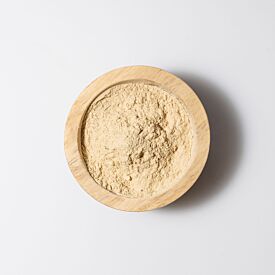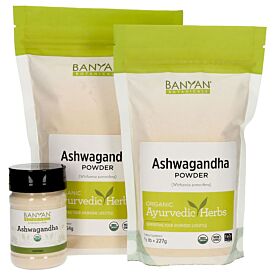Cultivating Calm

Do you struggle with fear or anxious feelings? These are expressions of excess vata in mano vaha srotas (the channel of the mind). Balanced vata is credited with a number of positive mental and emotional capacities like creativity, joy, intuition, expansiveness, clairvoyance, and deep spiritual understanding.
However, when aggravated vata accumulates in the channel of the mind, it tends to cause constriction—which can lead to feeling fearful, anxious, contracted, and even lonely.
We will start by exploring how these imbalances occur in the first place, but the purpose of this article is to offer practical guidance on how to support a return to balance so that we can reclaim health and vitality throughout the mental and emotional spheres.
If the channel of the mind is a new concept for you, you might appreciate reading The Channel of the Mind: Ayurveda and the Mind-Body Connection as a foundation for what follows.
Like Increases Like
Ayurveda operates on the premise that like increases like, and that opposites balance. Vata dosha is naturally light, cold, dry, rough, mobile, subtle, and clear. Therefore, exposure to these qualities—whether through our diets, lifestyle habits, relationships, or experiences—tends to increase vata. On the other hand, vata is balanced by foods and experiences that are heavy, warm, nourishing, substantive, oily, stabilizing, and concrete (or tangible) in nature.
Balancing Feelings of Anxiousness
Feelings of fear and anxiousness are among the most classic expressions of excess vata, and these imbalances are particularly likely to be triggered by excesses in the light, cold, and dry qualities.
Therefore, using diet, lifestyle, and supportive herbs to increase our exposure to heavy, warm, and oily influences will generally serve to relieve feelings of fear and anxiousness. These qualities help to ground, nourish, and lubricate aggravated vata.
Supportive Lifestyle Habits
Lifestyle therapies provide a potent means of calming vata. The fact that vata is the subtlest of the three doshas by nature means that it is more easily impacted by subtle energies than are pitta and kapha. This is particularly true when a vata imbalance is affecting a subtle channel like that of the mind.
But lifestyle therapies are very useful in balancing vata for another reason, and that is that elevated vata also tends to inhibit agni (the digestive fire), and can leave one’s digestion rather irregular and unpredictable. Unfortunately, when the digestive fire is compromised, the efficacy of any food or herb-based therapy suffers. After all, even the most perfect food or herb cannot reliably foster a return to balance if we cannot digest it properly.
By contrast, even small adjustments in our lifestyle habits often serve to quickly and efficiently pacify elevated vata. In truth, these types of therapies frequently help calm vata enough to strengthen digestive health and can prepare us to successfully introduce foods and herbs that will further promote balance.
The following lifestyle habits are particularly adept at calming vata in the mind.
A Daily Routine
Nearly everywhere we look in nature, there are creatures engaging in some sort of consistent daily routine that is deeply influenced by the rhythms of nature—the rising and setting of the sun, the cycles of the seasons, and the underlying impulses directing the broader community of life.
While there is often some degree of seasonal variation, many plants and animals embrace a predictable daily rhythm and, as a rule, live by it. As humans, we have largely gotten away from this habit. We engage with life at all hours of the day and night, and many of us have jobs and other obligations that require us to keep irregular schedules.
But at the most fundamental level, our physiology is very much adapted to—and supported by—some sense of regularity. Actually, this is precisely why the daily routine is such potent medicine, particularly for reducing feelings of anxiousness.
The routine itself has a very grounding and stabilizing effect on the system; it creates a number of familiar and comforting reference points throughout each day that send a resounding affirmation to the deep tissues of the body that all is well, that we can be at ease.
When the body becomes accustomed to—and learns to count on—a daily routine that includes things like adequate rest, appropriate exercise, and a nourishing spiritual practice, the mind and the nervous system naturally begin to relax.1 This alone serves to calm vata in the mind.
But adopting a daily routine is also a very purposeful and enduring act of love and self-care. Each day, our routines provide us with a tangible opportunity to prioritize our own health and well-being, regardless of what else might be going on in our lives. They become poignant reminders that we are, in fact, worthy of a healthy dose of loving attention every single day.
The cumulative effect of caring for ourselves in this way is quite powerful, very vata-pacifying, and, for many, results in a greatly improved sense of wellness in a very short period of time.
But because vata tends to be scattered, and can have a difficult time following through on commitments, simplicity is equally important. In other words, when vata is aggravated, less truly is more. Consider starting with just a few simple adjustments:
- Wake up at the same time from one day to the next.
- Eat breakfast, lunch, and dinner at about the same times each day.
- Go to sleep at a consistent time.
- Choose just one or two of the below strategies to complement this foundation.
You can always add more to your routine as the feelings of anxiousness settle down and your system comes into better alignment with your natural state of balance. But for the time being, biting off more than you can chew is very likely to backfire. Pay attention to those practices you are particularly drawn to and inspired by.
Mindfulness Practices
It takes both time and focused attention to re-pattern the mind, and daily practice is one of the best ways to ensure your success. Remarkably, as little as fifteen minutes per day is enough to be transformative, and committing to a daily practice will deliver results rather quickly. If you are serious about alleviating your feelings of anxiousness, choose one of the following practices and commit to doing it on a daily basis:
Meditation or Prayer
Both meditation and prayer tap into the subtle channels of the mind and can help to re-pattern even our most habituated responses to challenging situations. These practices serve to clear and quiet the channels of the mind, support the flow of prana (the vital breath) throughout the system, and encourage the proper digestion of food, thoughts, and emotions—all of which can help to relieve feelings of anxiousness.
If you do not have an established practice, So Hum Meditation is very helpful in calming anxious feelings, and is a wonderful practice suitable to most anyone. For additional support, you might try focusing your attention on the crown of the head while you practice.2
Pranayama
Stimulated by and carried on the breath, prana infuses every cell and tissue throughout the body with life. Interestingly, disturbances in prana are usually directly tied to the emergence of fear and feelings of anxiousness.
Therefore, the practice of specific pranayamas (yogic breathing exercises aimed at balancing the movement of prana throughout the system) can be quite a potent means of calming feelings of anxiousness.
In general, pranayama helps to restore fluidity and vitality to the subtle energy channels of the body, releases accumulated tension, and offers deep support to the mind and the nervous system.
Pranayama also activates and balances many of the most significant subtle channels influencing the mind, including mano vaha srotas (the channel of the mind), prana vaha srotas (the prana-carrying channel), ida nadi (the lunar, feminine channel), pingala nadi (the solar, masculine channel), and sushumna nadi (the central channel).
Therefore, pranayama is a powerful means of accessing and resetting longstanding psycho-spiritual patterns. For a more detailed exploration of these subtle channels and their significance in the broader landscape of the body, please see the following resources: The Channel of the Mind: Ayurveda and the Mind-Body Connection, and Vibrant Heart: An Ayurvedic Guide to Heart Health.
If you are new to pranayama, start with full yogic breath to ensure that you are breathing correctly. Once you feel comfortable, consider working with nadi shodhana pranayama (alternate nostril breathing) to more specifically calm the mind and reduce fear and feelings of anxiousness.
Start with just ten to fifteen minutes each day and notice what happens. If you prefer a guided practice, consider Dr. Claudia Welch’s Prana CD, which includes a beautiful, hands-free version of alternate nostril breathing.
Yoga
Yoga positively impacts the mind in very similar ways. It moves prana in the body, helps to dissipate tension, clears stagnation, and encourages fluidity throughout the tissues, the subtle body, and the mind.
Yoga also stimulates circulation, and serves as a balanced form of exercise, which is important when trying to balance feelings of anxiousness. Favor vata-pacifying yoga, with a particular emphasis on restorative poses like savasana to clear accumulated vata from mano vaha srotas.
Marma Points
As one of the openings to the channel system of the mind, the marmani (precise energy points on the surface of the skin that are connected to deeper, subtle energetic pathways throughout the body) provide a particularly potent means of correcting imbalances in mano vaha srotas.
One marma point that provides a simple access point for balancing feelings of anxiousness is known as tala hrida marma, and is located in the palm of the hand. To find it, make a fist with your left hand and notice where the left middle finger touches the left palm, (between the second and third metacarpals); this is tala hrida.3 Simply press the thumb of the right hand firmly into this marma point for about a minute to calm the mind, relieve feelings of anxiousness, and support concentration.4
Nasya
Nasya, the practice of applying medicated oil to the upper nasal passages, is actually seen as a way of offering a deeply influential therapy directly to the tissues of the brain. Nasya soothes the delicate tissues of the nose, fosters unobstructed breathing, relieves accumulated stress, promotes mental clarity, and generally supports the mind.
Nasya Oil generally helps to pacify vata in mano vaha srotas, and has a very calming effect on the mind and the nervous system. Nasya should not be performed by pregnant or menstruating women. Otherwise, apply three to five drops into each nostril (ideally, in the morning on an empty stomach). If you are new to the practice of nasya, please see our helpful instructional video.
Abhyanga (Ayurvedic Oil Massage)
Abhyanga, the ancient practice of self-massage with oil, calms the nervous system, lubricates and rejuvenates the tissues, and promotes healthy circulation throughout the body. It is no coincidence that the Sanskrit word for oil, sneha, also means love.
Abhyanga is a profound practice of rejuvenation and loving self-care that benefits both the physical body and the more subtle realms of consciousness. In addition, the oil itself forms a protective sheath around the body that can help to buffer the nervous system and the mind against undue stress or feelings of anxiousness.
Each morning, before a shower or bath, massage about 1/2 cup warm Vata Massage Oil or Organic Sesame Oil into the skin, hair, and scalp. You will find more detailed instructions on this rejuvenating technique and a helpful instructional video on our self-massage guide.
Simplified Oil Massage: Oil the Feet and Scalp before Bed
If a full-bodied abhyanga is sometimes too involved, consider applying a calming oil such as Brahmi Oil or Bhringaraj Oil to the soles of the feet and (if desired) to the scalp before bed.
This practice helps to relax the mind, ground the energy, and encourage sound sleep—all of which help to alleviate feelings of anxiousness. Don’t forget to protect your sheets by wearing a pair of old socks and a hat (or cover your pillow with an old towel).
Ginger Baking Soda Bath
A bath relaxes the nervous system, releases tension, and helps to quiet the mind. A ginger baking soda bath helps reduce feelings of anxiousness because it is deeply vata-pacifying.
The ginger and baking soda make this bath particularly soothing and heating; their qualities encourage circulation, sweating, and detoxification, and are especially helpful in offsetting the cold and dry qualities so often associated with feelings of anxiousness.
Simply add 1/3 cup baking soda and 1/3 cup ginger powder to a hot bath and soak for ten to fifteen minutes.5 If your pitta is high, you may not want to stay in the bath as long.

Appropriate Exercise
When engaged appropriately, exercise can be a panacea for improved health. Proper exercise helps to warm the body, improve circulation, release accumulated tension, and move stagnant mental and emotional energy. It also kindles agni (which is essential to optimal health), improves digestion, bolsters the body’s detoxification mechanisms, and encourages proper elimination, relaxation, and sound sleep—all of which help to curb feelings of anxiousness.
Ayurveda offers the unique perspective that the type, duration, and intensity of exercise that is most balancing for each of us depends largely on our constitution and current state of balance—take the Ayurvedic Profile™ quiz if you are unsure of yours.
For most people who frequently experience feelings of anxiousness, a vata-pacifying exercise routine that is gently paced and grounding is most appropriate. Calming activities such as walking, vata-pacifying yoga, chi gong, or tai chi are usually supportive options.
In general, Ayurveda suggests that we exercise to only about fifty percent of our capacity—until we break a mild sweat on the forehead, under the arms, and along the spine, or until the first signs of dryness in the mouth.6
If you are not currently exercising regularly, keep in mind that a supportive exercise program does not have to be complex or time-intensive; a daily twenty-minute walk can do wonders for the entire system.
A Supportive Diet
Learning to eat a balanced diet can be an overwhelming and time-consuming endeavor. But when we’re dealing with frequent feelings of anxiousness, our lives are often rather complicated, and (because opposites balance) our systems will generally respond better to solutions that are comparatively simple.
To balance vata, the diet needs to be a wholesome source of warmth, nourishment, and grounding. While you can certainly study the nuances of eating a vata-pacifying diet, as well as specific foods to balance vata, it is probably best to focus on emphasizing healthy, whole foods while minimizing processed foods, stimulants, and refined sugars—which we often reach for when time is short and our bodies crave nourishment.
Soups, stews, root vegetables, and other warm, simple, grounding foods are usually good choices. Or, choose prepared foods that are aligned with the healthy, whole-food model. Asian restaurants and the prepared foods section of many health food stores often have a good range of options.
Herbs for Calming the Mind
Tranquil Mind
Tranquil Mind tablets are specifically formulated to soothe and calm the nerves without creating dullness or lethargy. This powerful blend of herbs pacifies vata in the mind, promotes peace and well-being, and helps to bolster equanimity in the face of everyday stressors.
Stress Ease
Stress Ease tablets offer strength, resiliency, and tone to the neuromuscular system, helping the body to better cope with stress and tension. This potent blend of herbs introduces rejuvenative qualities that buffer the body against weakness, fatigue, and overwhelm—helping us face physical, mental, and emotional challenges alike with greater ease. It also offers a sustained source of natural energy that can help us cope with the demands of daily living.
Ashwagandha
Ashwagandha has long been celebrated for its ability to support the body in coping with stress and feelings of anxiousness while calming the mind. As a highly regarded adaptogen, Ashwagandha encourages quality energy throughout the day and sound sleep at night. Ashwagandha powder and liquid extract are also available.
Bacopa
Bacopa is an excellent rejuvenative for the mind and the nerves. It is renowned for soothing the nervous system while promoting memory, intelligence, concentration, and an overall balanced state of mind.
Mellow Mind
Mellow Mind is a soothing and relaxing herbal tea blend that features ingredients like chamomile, lavender, and gotu kola. The perfect tea for stressful days, you can sip it after a long day of work, before bedtime, or whenever you need to unwind.
Healthy Vata
Healthy Vata tablets contain herbs that help calm excess vata in the body and especially in the mind. Particularly helpful during the vata time of year (fall into early winter), they can be taken year-round by those with vata constitutions, or by anyone looking to bring vata dosha into balance.
Additional Resources
Keep in mind that feelings of anxiousness do not develop in a vacuum. It occurs only within the larger context of who we are—body, mind, and spirit. If you feel inspired to study the bigger picture, we have a number of other articles that may further inform your journey towards optimal health. The following resources are particularly relevant to the topics of fear, stress, and elevated vata in the mind:
An Ayurvedic Guide to Stress Management explores fantastic tools for reducing stress and for changing our relationship with stressful situations. Stress and feelings of anxiousness are often closely linked, so this resource might very well support your healing process.
An Ayurvedic Guide to Balanced Sleep is an extremely useful resource if you feel that your feelings of anxiousness are negatively impacting your ability to get adequate rest.
Vibrant Heart explores the critical connection between the mind, the heart, and the subtle channels of the energetic body. It can be an insightful resource for balancing feelings of anxiousness and excessive mental chatter by tending to the heart center.
The Importance of Healthy Digestion introduces the concept of agni (which is the very foundation of health) and offers an in-depth exploration of the importance of tending to yours.
Our Guide to Healthy Elimination is relevant due to the natural connection between overall health and digestive health—which, of course, is reflected in the quality of our elimination.
Building a Healthy Immune System can inform a natural approach to bolstering ojas and immune health, which are often compromised by elevated vata.
Our Fall Season Guide suggests a number of strategies for pacifying vata and for staying warm, grounded, and nourished—both mind and body—during the potentially aggravating autumn season.
Address Fear Your Way
Remember, one of the primary tenets of Ayurveda is that the best results come when we treat individuals—not their symptoms. Balancing fear is no exception. While the above suggestions are aimed at curbing tendencies toward feelings of anxiousness, each of us has a different constellation of influences affecting our overall health.
Factors such as constitution, current state of balance, age, environment, khavaigunyas (personal weaknesses), and the season, can be important considerations in crafting an effective treatment plan. This is why working with a qualified Ayurvedic practitioner can be invaluable.
Rather than sifting through a long list of possible remedies, you can focus on those that would most deeply serve your system in particular. Even if you are navigating an Ayurvedic lifestyle on your own, it is critical to understand that who you are is far more important than the particular ailments that you may be trying to correct.
This is your adventure. Chances are that the therapeutic strategies that most resonate with you will have a particularly potent impact on your state of balance. So listen to your body, your heart, and your intuition. Trust your gut. Follow your inspiration. Keep it simple. Go slow. And most importantly, enjoy the process.
We sincerely hope that we can continue to support you in cultivating a calm, balanced mind, and vibrant overall health.












